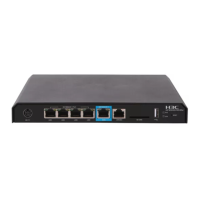33
Configuring priority marking
Priority marking sets the priority fields or flag bits of packets to modify the priority of packets. For
example, you can use priority marking to set the DSCP value for a class of IP packets to control the
forwarding of these packets.
To configure priority marking to set the priority fields or flag bits for a class of packets, perform the
following tasks:
1. Configure a traffic behavior with a priority marking action.
2. Associate the traffic class with the traffic behavior.
Priority marking can be used together with priority mapping. For more information, see "Configuring
priority mapping."
Configuration procedure
To configure priority marking:
1. Enter system view.
system-view
N/A
2. Create a traffic class and
enter traffic class view.
traffic classifier
classifier-name [
operator
{
and
|
or
} ]
By default, no traffic
class exists.
3. Configure match criteria.
if-match
[
not
]
match-criteria
By default, no match
criterion is configured.
For more information
about the
if-match
command, see ACL and
QoS Command
Reference.
4. Return to system view.
quit
N/A
5. Create a traffic behavior
and enter traffic behavior
view.
traffic behavior
behavior-name
By default, no traffic
behavior exists.
6. Configure a priority
marking action.
• Set the DSCP value for packets:
remark dscp dscp-value
• Set the local precedence for packets:
remark local-precedence
local-precedence-value
Use one of the
commands.
By default, no priority
marking action is
configured.
7. Return to system view.
quit
N/A
8. Create a QoS policy and
enter QoS policy view.
qos policy
policy-name
By default, no QoS
policy exists.
9. Associate the traffic class
with the traffic behavior in
the QoS policy.
classifier
classifier-name
behavior
behavior-name
By default, a traffic class
is not associated with a
traffic behavior.
10. Return to system view.
quit
N/A
11. Apply the QoS policy to an
interface.
Applying the QoS policy to an interface
By default, no QoS
policy is applied to an
interface.

